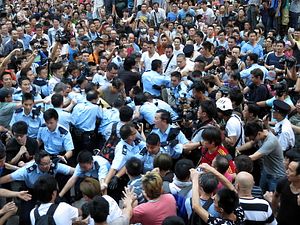Hong Kong police are reporting that up to 200 gangsters from local triads were sent out to to infiltrate both pro- and anti-Occupy protests in Mong Kok. “They were well organized and came with a purpose,” Superintendent Dan Ng Wai-hon of Hong Kong’s Organized Crime and Triad Bureau (OCTB) told South China Morning Post.
On Friday, October 3, violent scuffles broke out between protestors and counter-demonstrators. The anti-Occupy forces tried to forcibly expel the protestors from their camps in Mong Kok, a densely-populated district in Kowloon. The anti-Occupy group, called “Blue Ribboners” for the ribbons they wore (as opposed to the yellow ribbons that have come to symbolize the protestors), claimed to be representing normal Hongkongers who wanted to get back to work.
However, pro-Occupy protestors, including movement founder Benny Tai, claimed that the attackers were connected to Hong Kong’s triads and had been paid to use violence to break up an otherwise peaceful protest movement. Democratic Party chairman Martin Lee and the Hong Kong Federation of Students both accused the Hong Kong government of working with the triads to attack the protests. “Because of the presence of the international press, the police won’t use tear gas again to throw the people away,” Lee said after joining the protestors at Admiralty. “So they use these triad society members to create a scene and threaten the people.”
The police, in a press conference on October 6, blamed the violence on the “serious traffic jam” and “severe impacts on the residents and shopkeepers” in Mong Kok. “This also creates grievance of the public [sic] and can lead to chaos and confrontations,” Chief Superintendent of Police Public Relations Hui Chun-tak told reporters. Due to the ongoing clashes, police classified Mong Kok as a “high risk area” and urged protestors to leave the area.
However, even in the immediate wake of the Mong Kok clashes, police were reporting that some of the men involved had connections to Hong Kong triads. Of the 19 men arrested on October 3, police said that eight were suspected of having ties to organized crime. The information released on Monday provides more insight into the activities of triad members in Mong Kok. Ng said that triad members working with counter-demonstrators helped attack pro-Occupy protestors. Others, posing as Occupy supporters, tried to incite violence by challenging and even attacking police officers on the scene.
Ng said that the Hong Kong police has sent about 300 plain-clothes officers to Mong Kok to prevent further violence. He also said that the police are investigating whether the involved triad members had been paid to cause chaos, or whether they were simply seeking to put an end to protests that have harmed triad business interests in Mong Kok.
The latter question is the most significant. Protestors have alleged that the triad members were working with the Hong Kong police force, the Hong Kong government, and/or Beijing itself, but to date no solid evidence has come out backing those claims. Others have suggested that the triads could simply have been hired to act as the muscle for local business interests, as protests in Mong Kok effectively quashed business operations for over a week.
































